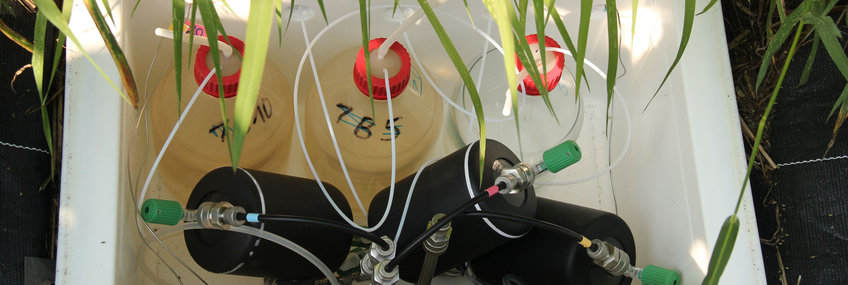
Inductively Coupled Plasma Optical Emission Spectroscopy (ICP-OES)
We use optical emission spectrometry for the analysis of trace elements in plant, soil and water samples from our experiments and field sites. For long-term studies investigating the effects of land use, species composition, soil cultivation and fertilisation on ecosystems in connection with climate change, analyses of the elemental balance are fundamental.
Inductively coupled argon plasma
An inductively coupled argon plasma is generated by superimposing radio frequency radiation of 700 -1000 W in a copper coil through which argon flows. This induces an alternating current in the coil that oscillates at a frequency of 27 or 40 MHz. It generates both an electric and a magnetic field in the coil. Ignition sparks snatch electrons from the argon, which are accelerated in the magnetic field and release further electrons by colliding with argon atoms. This triggers a chain reaction. A plasma is formed consisting of argon atoms, argon ions and electrons. This process is called inductive coupling.
Measuring principle
Spectroscopic analyses such as ICP-OES are based on the interaction of electromagnetic radiation with atoms, ions or molecules. They are used to identify chemical substances (qualitative analysis) and to determine their concentration (quantitative analysis). Basically, the measurement is carried out with liquid or previously liquefied samples. Direct analysis of solid samples (plant material, soil, etc.) is not possible. The analysis of such samples must be preceded by digestion.
The liquid sample is passed through a capillary and atomised under pressure so that an aerosol is formed. This process is called "nebulisation". The aerosol enters the spray chamber, which ensures that only enough small drops (diameter 10 µm or less) reach the actual plasma. This corresponds to approx. 1-5% of the total sample aerosol. The rest of the sample (95-99% of the aerosol) is discarded. Thus, the atomisation influences the sensitivity of the measurement, i.e. the detection and determination limits.
The actual atomisation of the sample takes place in an argon plasma at 6000 - 8000 °C after it has been freed from the solvent and evaporated beforehand. The excited atoms and ions emit light of different wavelengths, mainly from the UV range, but also from the visible spectrum (such as potassium and sodium). This polychromatic radiation, so-called "white light", is split into its individual components in the optical part of the measuring device, the spectrometer, i.e. into monochromatic radiation of decided wavelengths. Various optical components, such as diffraction grating and Echelle grating, are used for this purpose.
The intensity of a specific wavelength is measured by the detector without interfering with other wavelengths. The quantification of the different elements in the sample is therefore based on the intensity of their measured emission radiation after appropriate calibration.
ICP-OES is a multi-element method, i.e. several elements in a sample can be measured simultaneously. For example, 16 elements are regularly determined in water samples from our laboratory: Al, B, Ca, Cd, Cu, Fe, K, Mg, Mn, Na, Ni, P, S, Si, Sr, Zn.
Sample preparation
If components of solid samples, such as the elements Ca, Fe, K, P as micronutrients of plants, are to be determined, the corresponding samples must first be converted, i.e. liquefied, into a form accessible for analysis by ICP-OES. This process is called digestion. It is carried out using microwave radiation, concentrated acids, as well as elevated temperatures and pressures in a special digestion device.
The process includes the precise weighing of the sample material, the quantitative transfer of the sample into the digestion vessels, the careful addition of the concentrated acids required for digestion (mostly nitric acid, but also hydrochloric acid, hydrofluoric acid or mixtures), the careful sealing of the vessels and their insertion into the digestion rotor.
Digestion takes place at temperatures > 200 °C and pressures > 40 bar!
After digestion, the rotor with the vessels is removed and checked for any damage. Only then are the decomposition vessels removed and carefully ventilated in the fume hood to release any excess pressure that may still be present. Otherwise, there is a danger to people and the environment from uncontrolled escaping nitrous gases.
In a further step, the contents of the digestion vessels, consisting of concentrated acids and digested sample, are filtered and carefully transferred to volumetric flasks to avoid any loss of sample, which would lead to incorrect measurement results. The contents of the volumetric flasks are then filled up to the mark with distilled water and thus prepared for measurement by ICP-OES.
Concentrated acid is then added to the digestion flasks again and the digestion procedure is carried out again as described, but without the sample. In this way, the digestion vessels are cleaned and prepared for a new sample digestion.